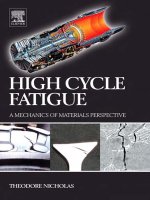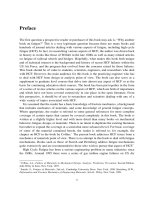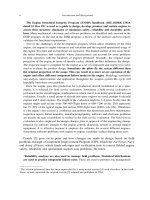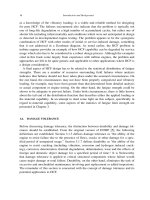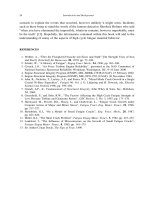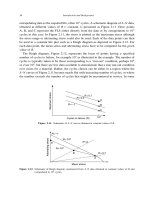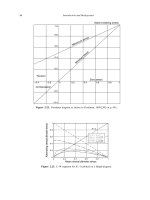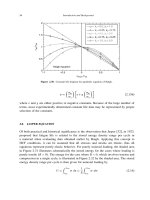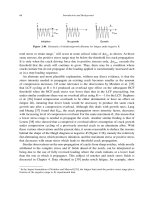High Cycle Fatigue: A Mechanics of Materials Perspective part 9 docx
Bạn đang xem bản rút gọn của tài liệu. Xem và tải ngay bản đầy đủ của tài liệu tại đây (209.62 KB, 10 trang )
66 Introduction and Background
Δσ
tot
σσσ
Δσ
pos
Initiation No growth Growth
Figure 2.40. Schematic of initiation/growth dilemma for fatigue under negative R.
total stress or strain range,
∗
will occur at some critical value of
tot
as shown. At those
same stresses, the positive stress range may be below the threshold for crack propagation.
It is only when the crack driving force due to positive stresses only,
pos
, exceeds the
threshold that the crack will continue to grow. Thus, there may be a condition where
cracks initiate but do not propagate if the loading applied is incrementally increased such
as in a step-loading sequence.
An alternate and more plausible explanation, without any direct evidence, is that the
stress intensity needed to propagate an existing crack becomes smaller as the amount
of compression increases. Of some relevance is the observation by Moshier et al. [35]
that LCF cycling at R = 01 produced an overload type effect on the subsequent HCF
threshold when the HCF peak stress was lower than that in the LCF precracking, but
under similar conditions there was no overload effect using R =−1 for the LCF. Stephens
et al. [36] found compression overloads to be either detrimental or have no effect on
fatigue life, meaning that lower loads would be necessary to produce the same crack
growth rate after a compression overload. Although this deals with growth rates, Lang
and Huang [37] found that K
PR
, the crack propagation stress intensity factor, decreases
with increasing level of compression overload. For the same maximum K, this means that
a lower stress range is needed to propagate the crack. Another similar finding is that of
Lenets [38] who showed that a compressive overload allows resumption of crack growth
under compression cycling of a previously arrested crack in an aluminum alloy. With
these various observations and the present data, it seems reasonable to deduce the reasons
behind the shape of the Haigh diagram at negative R (Figure 2.38), namely the relatively
flat alternating stress which produces initiation, and the maximum stress or positive stress
that decreases with mean stress which leads to threshold crack propagation.
Similar observations on the non-propagation of cracks from sharp notches, while mostly
attributed to the complex stress and K fields ahead of the notch, can be interpreted as
being due to the use of fully reversed loading where the crack initiates at a lower load
than the one at which it propagates. This subject of notches and notch stress fields is
discussed in Chapter 4. Data obtained in [39] under notch fatigue, for example, show
∗
In the Jasper formulation of Nicholas and Maxwell [29], the fatigue limit used the positive stress range plus a
fraction of the negative range to fit experimental data.
Characterizing Fatigue Limits 67
0
1
2
3
4
5
6
–5 –4 –3 –2 –1 0 1 2 3
Frost & Dugdale data
Broken or uncracked
alt broken
max broken
alt uncracked
max uncracked
Stress
Mean stress
Figure 2.41. Data from Frost and Dugdale [39] showing boundary between cracked and uncracked specimens
as function of mean stress.
that for the case where several mean stresses were used in notch fatigue, the only cases
where arrested cracks were observed were under cycling at negative values of R. Those
data are plotted as a function of mean stress (dimensionless) in Figure 2.41. Individual
data points show both the alternating as well as the maximum stress where specimens
were found to be either cracked or uncracked. The maximum stress can be interpreted
as the quantity needed to propagate a crack when R is negative whereas the alternating
stress (or twice the alternating stress for R>05) governs both crack initiation and crack
propagation. For the right side of the diagram, corresponding to positive mean stress, the
boundary between broken and unbroken for alternating or mean stress follows the trends
seen in a typical Haigh diagram such as that in Figure 2.38. For negative mean stress,
the maximum stress for the broken specimens decreases slightly with decreasing mean
stress. This could indicate that there is a nearly constant value of positive stress that is
needed to fracture a specimen or cause an existing crack to continue to propagate. This
observation bears some consistency with the observation of the number of cycles in the
last block for smooth specimens, Figure 2.39, where the implication of the existence of
a precrack for negative R can be made.
REFERENCES
1. Wöhler, A., “Bericht über die Versuche, welche auf der Königl. Niederschlesisch-
Märkischen Eisenbahn mit Apparaten zum Messen der Biegung und Verdrehung von
Eisenbahn-wagen-Achsen während der Fahrt, angestellt wurden”, Zeitschrift fur Bauwwesen,
8, 1858, pp. 642–651.
68 Introduction and Background
2. Bathias, C., Drouillac, L., and Le Francois, P., “How and Why the Fatigue S–N Curve does
not Approach a Horizontal Asymptote”, Int. J. Fatigue, 23, Supp. 1, 2001, pp. S143–S151.
3. Bathias, C., “There is no Infinite Fatigue Life in Metallic Materials”, Fatigue & Fracture of
Engineering Materials & Structures, 22, 1999, pp. 559–565.
4. Bathias, C., “Relation Between Endurance Limits and Thresholds in the Field of Gigacycle
Fatigue”, Fatigue Crack Growth Thresholds, Endurance Limits, and Design, ASTM STP 1372,
American Society for Testing and Materials, West Conshohocken, PA, 2000, pp. 135–154.
5. Marines, I., Bin, X., and Bathias, C., “An Understanding of Very High Cycle Fatigue of
Metals”, Int. J. Fatigue, 25, 2003, pp. 1101–1107.
6. Atrens, A., Hoffelner, W., Duerig, T.W., and Allison, J.E., “Subsurface Crack Initiation in
High Cycle fatigue in Ti6Al4V and in a Typical Martensitic Stainless Steel”, Scripta Met., 17,
1983, pp. 601–606.
7. Shiozawa, K., Lu, L., and Ishihara, S., “S-N Curve Characteristics and Subsurface Crack
Initiation Behaviour in Ultra-Long Life Fatigue of a High Carbon-Chromium Bearing Steel”,
Fatigue Fract. Engng Mater. Struct., 24, 2001, pp. 781–790.
8. Li, J., Yao, M., and Wang, R Z., “A New Concept for Fatigue Strength Evaluation of Shot
Peened Specimens”, Proceedings of the ICSP4, 4th International Conference on Shot Peening,
Tokyo, 1990, pp. 255–262.
9. Morrissey, R.J. and Nicholas, T., “Staircase Testing of Titanium in the Gigacycle Regime”,
presented at 3rd International Conference on Very High Cycle Fatigue (VHCF-3), Ritsumeikan
University, Shiga, Japan, September 16–19, 2004 (to be published in Int. J. Fatigue).
10. Ochi, Y., Matsumura, T., Masaki, K., and Yoshida, S., “High-Cycle Rotating Bending Fatigue
Property in Very Long-Life Regime of High-Strength Steels”, Fatigue Fract. Engng. Mater.
Struct., 25, 2002, pp. 823–830.
11. Fatigue and Fracture of Engineering Materials and Structures, 22, No. 7, 1999.
12. Fatigue and Fracture of Engineering Materials and Structures, 25, No. 8/9, 2002.
13. Bathias, C. and Paris, P.C., Gigacycle Fatigue in Mechanical Practice, Marcel Dekker, New
York, 2005.
14. Caton, M.J., Jones, J.W., Mayer, H., Stanzl-Tschegg, S., and Allison, J.E., “Demonstration of
an Endurance Limit in Cast 319 Aluminum”, Metal. Mater. Trans., 34A, 2003, pp. 33–41.
15. Forrest, P.G., Fatigue of Metals, Pergamon Press, Oxford, 1962 (U.S.A. Edition distributed by
Addison-Wesley Publishing Co., Reading, MA).
16. Gunn, K., “Effect of Yielding on the Fatigue Properties of Test Pieces Containing Stress
Concentrations”, Aeronautical Quarterly, 6, 1955, pp. 277–294.
17. Murakami, Y., Metal Fatigue: Effects of Small Defects and Nonmetallic Inclusions, Elsevier
Science, Ltd, Kidlington, Oxford, 2002.
18. Sendeckyj, G.P., “Constant Life Diagrams – A Historical Review”, Int. J. Fatigue, 23, 2001,
pp. 347–353.
19. Haigh, B.P., “Experiments on the Fatigue of Brasses”, Journal of the Institute of Metals, 18,
1917, pp. 55–86.
20. Goodman, J., Mechanics Applied to Engineering, Vol. 1, 9th edn, Longmans, Green & Co.,
Inc., New York, 1930, p. 634; see also 1st edn, 1899, p. 455.
21. Fidler, T.C., A Practical Treatise on Bridge-Construction, Charles Griffin and Company,
London, 1887.
22. Soderberg, C.R., “Factor of Safety and Working Stress”, Trans., American Society of Mechan-
ical Engineers, 52, 1939, pp. 13–28.
Characterizing Fatigue Limits 69
23. Gerber, W.Z., “Relation Between the Superior and Inferior Stresses of a Cycle of Limiting
Stress (in German)”, Zeitschrift des Bayerischen Architekten-und Ingenieur-Vereins, 6, 1874,
pp. 101–110.
24. Launhardt, W., “The Stressing of Iron (in German)”, Zeitschrift des Architekten-und Ingenieur-
Vereins zu Hannover, 19, 1873, pp. 139–144.
25. Weyrauch, J.J., “Strength and Determination of the Dimensions of Structures of Iron and Steel
with Reference to the Latest Investigations” (English translation by A.J. DuBois) John Wiley
and Sons, New York, 1877.
26. Smith, R.H., “The Strength of Railway Bridges”, Engineering, London, 29, 1880, pp. 262–263.
27. Gallagher, J. et al., “Advanced High Cycle Fatigue (HCF) Life Assurance Methodologies”,
Report # AFRL-ML-WP-TR-2005-4102, Air Force Research Laboratory, Wright-Patterson
AFB, OH, July 2004.
28. Smith, K.N., Watson, R., and Topper, T.H., “A Stress-Strain Function for the Fatigue of
Metals”, Journal of Materials, 5, 1970, pp. 767–778.
29. Nicholas, T. and Maxwell, D.C., “Mean Stress Effects on the High Cycle Fatigue Limit Stress
in Ti-6Al-4V”, Fatigue and Fracture Mechanics: 33rd Volume, ASTM STP 1417, W.G. Reuter,
and R.S. Piascik, eds, American Society for Testing and Materials, West Conshohocken, PA,
2002, pp. 476–492.
30. Haigh, B.P., “The Relative Safety of Mild and High-Tensile Alloy Steels Under Alternating
and Pulsating Stresses”, Proceedings of the Institution of Automotive Engineers, 24, 1930,
pp. 320–347.
31. Heywood, R.B., Designing Against Fatigue of Metals, Reinhold Publishing Corp., New York,
1962.
32. Jasper, T.M., “The Value of the Energy Relation in the Testing of Ferrous Metals at Varying
Ranges of Stress and at Intermediate and High Temperatures”, Philosophical Magazine, Series.
6, 46, October 1923, pp. 609–627.
33. Maxwell, D.C. and Nicholas, T., “A Rapid Method for Generation of a Haigh Diagram
for High Cycle Fatigue”, Fatigue and Fracture Mechanics: 29th Volume, ASTM STP 1321,
T.L. Panontin, and S.D. Sheppard, eds, American Society for Testing and Materials, West
Conshohocken, PA, 1999, pp. 626–641.
34. Nicholas, T., “Material Behavior at High Strain Rates”, Impact Dynamics, Chap. 8, J. Zukas
et al. eds, Wiley, New York, 1982, pp. 277–332.
35. Moshier, M.A., Nicholas, T., and Hillberry, B.M., “High Cycle Fatigue Threshold in the
Presence of Naturally Initiated Small Surface Cracks”, Fatigue and Fracture Mechanics: 33rd
Volume, ASTM STP 1417, W.G. Reuter and R.S. Piascik, eds, American Society for Testing
and Materials, West Conshohocken, PA, 2002, pp. 129–146.
36. Stephens, R.I., Chen, D.K., and Hom, B.W., “Fatigue Crack Growth with Negative Stress
Ratio Following Single Overloads in 2024–T3 and 7075–T6 Aluminum Alloys”, Fatigue Crack
Growth Under Spectrum Loads, ASTM STP 595, American Society for Testing and Materials,
Philadelphia, 1976, pp. 27–40.
37. Lang, M. and Huang, X., “The Influence of Compressive Loads on Fatigue Crack Propagation
in Metals”, Fatigue Fract. Engng. Mater. Struct., 21, 1998, pp. 65–83.
38. Lenets, Y.N., “Compression Fatigue Crack Growth Behaviour of an Aluminium Alloy: Effect
of Overloading”, Fatigue Fract. Engng. Mater. Struct., 20, 1997, pp. 229–256.
39. Frost, N.E. and Dugdale, D.S., “Fatigue Tests on Notched Mild Steel Plates with Measurements
of Fatigue Cracks”, J. Mech. Phys. Solids, 5, 1957, pp. 182–192.
Chapter 3
Accelerated Test Techniques
3.1. HISTORICAL BACKGROUND
Since the beginning of fatigue research in the 1800s, the problems associated with long
life or HCF have produced an obvious need to generate data at very high numbers of
cycles. Turbine engine components undergoing high frequency resonances, reciprocating
automotive engines travelling hundreds of thousands of miles at several thousand rpm,
railroad wheels making contact with the rails on every revolution over hundreds of
thousands of miles, bridges carrying thousands of moving axle loads every day, and
rotating machine components that operate on a continuous basis are just some of the
examples where materials can be subjected to large numbers of cycles. While 10
6
10
7
,
and 10
8
may be typical design lives for some applications, even larger numbers are now
recognized as the actual cycle counts to which some materials and components may be
exposed in service. These large numbers of cycles may take many years to accumulate
in service whereas in design, data are needed in a much shorter period of time.
Historically, researchers have devoted considerable effort to developing both equipment
that can operate at high frequencies and test procedures to accelerate the manner in
which the long-life fatigue limit can be determined. Lacking either, obtaining data at long
cycle counts could take weeks, months, or even years. Testing machine frequencies have
been improved in response to the need for longer life testing. Laboratory testing with
servo-hydraulic machines up to frequencies approaching 1 kHz is becoming state of the
art [1].
The field of “gigacycle fatigue” has seen great interest in recent years because of the
need to obtain material fatigue strength data at exceedingly high cycle counts. The subject
was discussed in the previous chapter. Regarding the testing technique, piezoelectric test
devices have been developed that operate with an axial specimen in a longitudinal first
mode resonance condition at the driving frequency of 20 kHz [2]. The frequency of the
driving force has been extended to 30 kHz [3] using the same excitement principle.
3.1.1. Coaxing
These new test techniques and other advances in electronics, instrumentation, computers,
and other technical fields have provided the capability to evaluate the long life fatigue
behavior of materials far beyond what was envisioned in the late nineteenth and early
twentieth centuries. Yet, in that time period, concerns were expressed by early fatigue
70
Accelerated Test Techniques 71
researchers over the needs for accelerated test methods and the possible existence of load-
history effects such as coaxing. Noting that endurance testing is very time consuming,
Gough [4] identified a critical need for rapidly determining fatigue endurance limits. He
noted that the requirements of such a test are:
1. It must be expeditious.
2. It should be simple, not requiring elaborate apparatus, or particularly skilled personnel.
3. It should require the minimum number of specimens, which should be of a simple
form.
4. It must be accurate.
Gough [4], however, noted that by subjecting a material to periods of cycling in steps
of increasing magnitude, it can be made to withstand stresses considerably above the
primitive fatigue limit. This phenomenon is referred to as coaxing.
Coaxing refers to the subjecting of a material to stresses below those to which it may
be subjected in a long-life fatigue test. This phenomenon, also called “understressing,”
was investigated early by Smith [5] who first drew attention to the fact that understressing
might have an effect on the endurance limit of a material. In particular, he found that
many metals are permanently strengthened by under stressing them before fatigue testing
in the endurance limit stress regime. Similar examples of raising the fatigue limit by
understressing were also reported by Moore and Jasper [6].
Perhaps the most revealing statement regarding the coaxing phenomenon is that of
Walter Schütz [7], who, in writing about the history of fatigue, commented on whether
research results published in the fatigue literature were useful for the coming genera-
tions. He cites as a negative example works on understressing, “which uselessly haunted
people’s minds for decades.” He notes that Ransom and Mehl [8] and others “proved
by fatigue tests on a statistical basis that effects that had been claimed for decades, like
coaxing by understressing, did not exist.” In an extensive study of statistics of fatigue
involving numerous tests, Epremian and Mehl [9] showed that, in most cases, under-
stressed specimens have longer fatigue life than virgin specimens at a given stress in the
fracture range. While this type of conclusion is often noted in the literature, it has to
be pointed out that in the same paper they wrote that “the understressing effect may be
interpreted, in part, as a statistical phenomenon based on selectivity. Note that the speci-
mens used to demonstrate coaxing were taken from the population of unfailed specimens
tested using the staircase testing procedure. Therefore, they were in the upper range of
fatigue strengths because of the selectivity in choosing them and were not representative
of the general population of fatigue strengths.”
It has been noted over the years that coaxing occurs only in detectable form in ferrous
materials, is commonly associated with the phenomenon of strain ageing, and that the
final fracture stress after coaxing was greater if the stress was built up slowly [10]. Two
72 Introduction and Background
possible phenomena were suggested by Forsyth [11]. One is that understressing may
subject a material to less time at stress than in a conventional test and may reduce the
amount of environmental degradation. Such an accelerated step test may not be able
to simulate the time-dependent effects of atmospheric corrosion and strength-reducing
effects which might depend on corrosion. Another phenomenon may be the development
and arrest of microcracks at low stresses which would have propagated at higher stress
levels. One can only speculate that it may be more difficult to propagate an arrested
crack than to start one fresh in an untested material. While Forsyth noted that the coaxing
phenomenon had been associated with strain ageing, he concluded that “it is very likely
that the strain-ageing phenomenon is peculiarly effective in prohibiting the formation
of brittle-component growth, perhaps by plastically deforming the root of the crack and
upsetting what is a purely crystallographic cleavage process.”
When all is said and done, coaxing, if it exists at all, provides a beneficial effect to
a materials’ fatigue resistance. Any increase in FLS due to coaxing, however, seems
to depend on unknown combinations of material, loading history, and statistics of FLS
(discussed later in this chapter in Section 3.5.2). For these reasons, coaxing cannot and
should not be considered in design or in the development of a material database for
use in HCF design. Ignoring coaxing, however, can only be conservative because of the
improvements in FLS that have to, as yet, be demonstrated.
3.2. EARLY TEST METHODS
Standard methods for determination of the fatigue or endurance limit require not only a
large number of fatigue tests but also statistical analysis to establish their reliability [12].
Fatigue data corresponding to a given life or what is termed the greatest number of cycles,
N
g
, e.g. 10
7
, can be grouped into three categories according to applied stress level. At
high stresses, all specimens fracture before N
g
is reached. These stresses correspond to
the range of finite life. Over a range of lower stresses, at least one but not all of the
specimens fails before N
g
: this region is called the transition region. Finally, at some
lower stress level and below, no failures are obtained before N
g
: this is called the range
of infinite endurance. Testing is usually performed to identify the boundary between
the transition and infinite endurance regions. For each stress level, a minimum of ten
specimens are usually required, and four stress levels are recommended [12]. The data
are treated statistically to identify the endurance limit corresponding to a probability of
failure of less than some small amount like 1%, depending on the scatter in the data
and the width of the transition region. This approach, while both scientifically based
and statistically sound, requires an extensive amount of testing which is prohibitive for
many investigations, particularly when N
g
is a large number like 10
7
or greater. While
other non-standard or accelerated methods are available for determining the endurance
Accelerated Test Techniques 73
limit, the number of specimens and testing time are generally too large for practical
engineering applications. An example that requires a large database is a Haigh diagram,
which requires data at a number of mean stress or stress ratio conditions.
By early in the 1900s, numerous accelerated tests for endurance limit had been proposed
and rejected because they did not prove to be reliable. Among these early accelerated
tests was that of Moore and Wishart [13], who developed an “overnight” test based
on application of a fixed number of HCF cycles followed by determination of tensile
strength. The basis of this test was that fatigue testing below the endurance limit increases
the tensile strength and endurance limit, while above the endurance limit, cracks form
and ultimately degrade the tensile strength. Commenting on this paper, Gough stated,
“I have arrived definitely at the conclusion that no reliable form of short-time test known
has yet been devised” and he saw “no fundamental reason why any short-time test can
be expected to prove reliable.”
Later, Prot [14] developed a rapid test for determining the fatigue limit without using
conventional tests under constant stress conditions. His technique involved starting at a
stress below the estimated fatigue limit and increasing the stress at a constant rate until
failure occurs. Each successive test is conducted at a reduced rate of increase, thereby
producing a series of stress values associated with each rate of stress increase. In his
approach, one test specimen is required for each rate of increase in stress. Still, it was
claimed that this method reduces testing time by nine-tenths. The Prot method, though
not widely used today, is considered to be the standard of reference for accelerated testing
methods.
An illustrative example of the S–N behavior that is inherently assumed in the Prot
method is presented in Figure 3.1. Under the assumption used by Prot that the stress
400
450
500
550
600
650
700
5
6
78910
Prot S –N curve
σ
e
= 500
σ
0
=
490
σ
0
=
450
Stress
log N
Figure 3.1. Illustrative numerical example of assumed S–N behavior for Prot method.
74 Introduction and Background
is proportional to the square root of the rate of stress increase, a numerical example is
calculated assuming that the endurance limit stress is 500 (arbitrary units). For initial
starting values of 490 and 450, the expected S–N behavior based on the Prot assumption is
shown in the figure. While the method assumes that the starting stress in the constant rate
of stress increase is near the endurance limit, the calculations show that there is very little
difference when the two different values of initial stress are used. On the other hand, any
other shape of an S–N curve, particularly at large numbers of cycles near the endurance
limit, will not produce a straight line plot and thus makes it difficult to extrapolate to a
zero rate of increase of stress from which the endurance limit is determined in the Prot
method.
While concerns over coaxing persisted in accelerated test development, the Prot method
was validated by Ward et al. [15] on welded SAE 4340 steel and found to be applicable to
ferrous metals with a well-defined endurance limit [16]. However, Corten et al. [16] noted
that for ferrous metals that are susceptible to coaxing, the Prot procedure appreciably
raises the endurance limit compared to that obtained by conventional methods. In a
discussion of their paper, they pointed out the following: “Only if coaxing is absent and
the number of cycles in each step is sufficiently large (possibly 10
7
cycles), does it appear
reasonable to expect that the fracture stress data obtained from the step-up method will
agree with the endurance limit obtained from conventional tests.” Other work by Dolan
et al. [17] showed that improvement in the fatigue life by under-stressing depended a
great deal on the relative difference between the under-stress level and the endurance
limit. Re-testing with a small increase in stress level resulted in abnormally long life,
but re-testing with a large difference in stress level showed no apparent coaxing effect.
In structural steels, Hempel [18] observed that fully reversed bending fatigue at a stress
level 22% below the endurance limit did not lead to development of slip lines, even at
stress numbers in excess of 10
7
. At higher stress amplitudes, but still below the endurance
limit, slip traces occur only in individual crystallites. At stresses above the endurance
limit, slip markings were far more conspicuous and were present in a large number of
crystallites. But slip markings do not necessarily lead in every case to the formation of
micro- and macro-cracks or to fatigue failure.
The existence of a coaxing effect, while important in establishing the validity of an
accelerated test procedure of the type according to Prot, does not appear to have an
established scientific basis. One possible explanation of the coaxing effect is one which
is purely statistical in nature. Epremian and Mehl [19] point out that elimination of the
weaker specimens during fatigue testing below the fatigue limit biases the population of
specimens tested at higher stress levels. Because of the statistical selectivity, specimens
subsequently tested above the fatigue limit tend to show longer lives. For any of the
proposed explanations of the existence of a coaxing phenomenon, it is not felt that
coaxing is a real phenomenon in titanium alloys and, therefore, the step-loading test
procedure described in the next section is valid for determination of the fatigue limit. The
Accelerated Test Techniques 75
Prot approach has been found to be reasonably reliable for a titanium alloy [20] and an
alternate step-test method was validated in several investigations using Ti-6Al-4V as the
test alloy [21].
3.3. STEP TEST PROCEDURES
In addition to the Prot method described above, another form of accelerated test involving
step loading was developed by Maxwell and Nicholas [22]. At a fixed stress ratio, a
specimen is fatigued to a limit of typically 10
7
cycles at a stress level lower than the
expected fatigue limit. After each block of 10
7
cycles, the stress is increased by some
small amount (approximately 5% in their tests) until failure occurs at less than 10
7
cycles.
The FLS is then determined using a linear interpolation scheme as described in the
following equation:
e
=
0
+
N
fail
N
life
(3.1)
where
e
is the maximum fatigue strength corresponding to N
life
cycles,
0
is the previous
maximum fatigue stress that did not result in failure, is the step increase in maximum
fatigue stress, N
fail
are the cycles to failure at the fatigue stress (
0
+, and N
life
the
defined cyclic fatigue life (i.e., 10
6
10
7
, etc.). The linear interpolation concept embodied
in Equation (3.1) was developed from the idea that damage accumulation might be a
linear function of cycles. While no data were obtained to demonstrate that concept, use
of a similar formula to Equation (3.1) based on log N rather than N did not seem to
produce values that were as consistent as those with the linear formula when comparing
results to interpolated S–N data. For small step sizes, the differences did not appear to
be significant.
In much of the work under the National Turbine Engine High Cycle Fatigue Program
[23, 24], the step-loading procedure was used to obtain FLS data. Typical steps of 10
7
cycles are used, while is taken typically at 5% of the initial load block. The step-
loading procedure is shown schematically in Figure 3.2 for blocks of 10
7
cycles. The
size of the step depends on the degree of accuracy desired in determining the FLS. Steps
as high as 20% of the first block stress have been used to assess effects of FOD on
the fatigue limit [25]. In cases such as those, the degree of damage due to FOD is very
variable, so accurate determination of the FLS is not warranted. Further, the starting stress
for the first block is not very predictable, so small increments could result in a very large
number of steps and, consequently, long testing times.
There are some advantages to the use of the proposed technique other than the consid-
erable savings in testing time. The proposed technique results in failure in each specimen,
contrary to conventional fatigue testing where some fraction of specimens tested fail and

